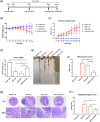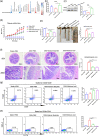An engineered probiotic secreting Sj16 ameliorates colitis via Ruminococcaceae/butyrate/retinoic acid axis
- PMID: 34589596
- PMCID: PMC8459592
- DOI: 10.1002/btm2.10219
An engineered probiotic secreting Sj16 ameliorates colitis via Ruminococcaceae/butyrate/retinoic acid axis
Abstract
Most inflammatory bowel disease (IBD) patients are unable to maintain a lifelong remission. Developing a novel therapeutic strategy is urgently needed. In this study, we adopt a new strategy to attenuate colitis using the Escherichia coli Nissle 1917 probiotic strain to express a schistosome immunoregulatory protein (Sj16) in the gastrointestinal tract. The genetically engineered Nissle 1917 (EcN-Sj16) highly expressed Sj16 in the gastrointestinal tracts of dextran sulfate sodium-induced colitis mice and significantly attenuated the clinical activity of colitis mice. Mechanistically, EcN-Sj16 increased the intestinal microbiota diversity and selectively promoted the growth of Ruminococcaceae and therefore enhanced the butyrate production. Butyrate induced the expression of retinoic acid, which further attenuated the clinical activity of colitis mice by increasing Treg cells and decreasing Th17. Strikingly, retinoic acid inhibitor inhibited the therapeutic effects of EcN-Sj16 in colitis mice. These findings suggest that EcN-Sj16 represents a novel engineered probiotic that may be used to treat IBD.
Keywords: Ruminococcaceae/butyrate/retinoic acid axis; Sj16; Treg/Th17 balance; colitis; engineered probiotic.
© 2021 The Authors. Bioengineering & Translational Medicine published by Wiley Periodicals LLC on behalf of The American Institute of Chemical Engineers.
Conflict of interest statement
The authors declare that there is no conflict of interest that could be perceived as prejudicing the impartiality of the research reported.
Figures







Similar articles
-
Beneficial effects resulting from oral administration of Escherichia coli Nissle 1917 on a chronic colitis model.Benef Microbes. 2020 Dec 2;11(8):779-790. doi: 10.3920/BM2020.0045. Epub 2020 Nov 16. Benef Microbes. 2020. PMID: 33191778
-
Nattokinase enhances the preventive effects of Escherichia coli Nissle 1917 on dextran sulfate sodium-induced colitis in mice.World J Microbiol Biotechnol. 2022 Nov 9;39(1):8. doi: 10.1007/s11274-022-03452-9. World J Microbiol Biotechnol. 2022. PMID: 36350434
-
Probiotic Escherichia coli Nissle 1917 Expressing Elafin Protects Against Inflammation and Restores the Gut Microbiota.Front Microbiol. 2022 May 6;13:819336. doi: 10.3389/fmicb.2022.819336. eCollection 2022. Front Microbiol. 2022. PMID: 35602072 Free PMC article.
-
Probiotic Escherichia coli NISSLE 1917 for inflammatory bowel disease applications.Food Funct. 2022 Jun 6;13(11):5914-5924. doi: 10.1039/d2fo00226d. Food Funct. 2022. PMID: 35583304 Review.
-
[The role of Escherichia coli strain Nissle 1917 in the gastro-intestinal diseases].Postepy Hig Med Dosw (Online). 2014 Nov 6;68:1251-6. doi: 10.5604/17322693.1127882. Postepy Hig Med Dosw (Online). 2014. PMID: 25380207 Review. Polish.
Cited by
-
Engineered microorganisms: A new direction in kidney stone prevention and treatment.Synth Syst Biotechnol. 2024 Mar 8;9(2):294-303. doi: 10.1016/j.synbio.2024.02.005. eCollection 2024 Jun. Synth Syst Biotechnol. 2024. PMID: 38510204 Free PMC article. Review.
-
Gut Microbiome and Transcriptomic Changes in Cigarette Smoke-Exposed Mice Compared to COPD and CD Patient Datasets.Int J Mol Sci. 2024 Apr 5;25(7):4058. doi: 10.3390/ijms25074058. Int J Mol Sci. 2024. PMID: 38612871 Free PMC article.
-
Engineering probiotic Escherichia coli Nissle 1917 to block transfer of multiple antibiotic resistance genes by exploiting a type I CRISPR-Cas system.Appl Environ Microbiol. 2024 Oct 23;90(10):e0081124. doi: 10.1128/aem.00811-24. Epub 2024 Sep 10. Appl Environ Microbiol. 2024. PMID: 39254327 Free PMC article.
-
Engineered probiotics.Microb Cell Fact. 2022 Apr 27;21(1):72. doi: 10.1186/s12934-022-01799-0. Microb Cell Fact. 2022. PMID: 35477497 Free PMC article. Review.
-
A Multifunctional Therapeutic Strategy Using P7C3 as A Countermeasure Against Bone Loss and Fragility in An Ovariectomized Rat Model of Postmenopausal Osteoporosis.Adv Sci (Weinh). 2024 Jun;11(21):e2308698. doi: 10.1002/advs.202308698. Epub 2024 Mar 13. Adv Sci (Weinh). 2024. PMID: 38477537 Free PMC article.
References
-
- Sun Y, Duan B, Chen H, Xu X. A novel strategy for treating inflammatory bowel disease by targeting delivery of methotrexate through Glucan particles. Adv Healthc Mater. 2020;9(6):e1901805. - PubMed
-
- Wang Y, Shen W, Shi X, et al. Alpha‐tocopheryl succinate‐conjugated G5 PAMAM dendrimer enables effective inhibition of ulcerative colitis. Adv Healthc Mater. 2017;6(14):1700276. - PubMed
-
- Ng SC, Shi HY, Hamidi N, et al. Worldwide incidence and prevalence of inflammatory bowel disease in the 21st century: a systematic review of population‐based studies. Lancet. 2017;390(10114):2769‐2778. - PubMed
LinkOut - more resources
Full Text Sources
Other Literature Sources

